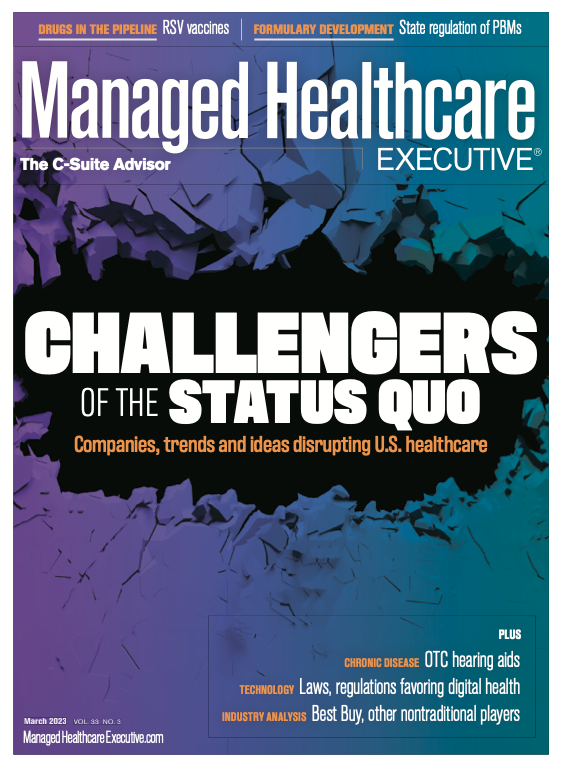Nontraditional Players Are Getting Into Healthcare Game
As ideas about what constitutes healthcare have expanded, so has the involvement of newcomers such as Best Buy.
Awide range of factors — from the money to be made in healthcare to a focus on social determinants of health to a demand for more consumer-driven care — are drawing more nontraditional players into the healthcare business. Consumer electronics giant Best Buy is investing in healthcare companies and sending its team members to patients’ homes to set up equipment for hospitals and health systems. And Lyft is providing transportation for patients in need of a ride to a medical appointment.
By partnering with such companies, payers and providers are “all looking to do one thing: meet patients that are members where they are,” says Tom Cassels, M.P.P., president and chief executive officer of Rock Health, a company headquartered in San Francisco that helps fund digital startups.
Such pair-ups can help traditional healthcare organizations build relationships and deepen understanding of their patients as they work with companies that have a consumer-first focus, Cassels says.
“It starts with appreciating that we need to redefine what we mean by health,” says Simon Gisby, life sciences and healthcare group leader at Deloitte. The COVID-19 pandemic ramped up recognition that an individual’s social and emotional circumstances can affect their physical health, Gisby says, and the “explosion in virtual care” that accompanied the pandemic made it easier for consumers to access care and “facilitate more continuous engagement.” Coincidentally, Medicaid, Medicare Advantage and some commercial health plans are now covering nonclinical services that are delivered in people’s homes, notes Cassels. That tech-enabled, in-home care could potentially help providers stay ahead of health issues that might arise, says Gisby, improving outcomes and reducing costs in the process.
With healthcare, retail, consumer products and technology companies all working together, “an ecosystem could be created,” Gisby says. “All bring different technology and expertise.”
Best Buy spent $400 million in 2021 to acquire Current Health, a technology platform for at-home care that brings together remote patient monitoring, telehealth and patient engagement. The company has also invested an undisclosed sum in Coeus.health, a remote patient monitoring company. Having a role in setting up remote patient monitoring equipment is “something that is within the skill set of Best Buy,” Cassels says.
Playing in the sandbox
“You’ll see some surprising names” at med-tech conferences these days, says Cassels, mentioning LG Electronics and Cox Communications. Late last year, LG Electronics and telehealth company Amwell
announced they were going to begin adapting the LG television sets used in hospitals and healthcare facilities so they could be used by providers to remotely engage with, monitor and discharge patients.
Cox Communications is offering such services as remote patient monitoring of patients who have been discharged from a healthcare facility. “All look at healthcare as an opportunity,” Cassels says. Federal actuaries say the healthcare sector accounted for 18.3% of the U.S. economy in 2021.
“The open question,” says Cassels, “is how well will the nontraditional players play in the sandbox with the traditional, entrepreneurial healthcare companies?”

Premiums for Employer-based Health Insurance Increased by 7% in 2024, Says KFF Report
Published: October 9th 2024 | Updated: October 9th 2024The 2024 increase is the same as last year's increase for family coverage. The foundation’s annual survey of employer health benefits also found that only 18% of large employers (200 employees are more) are covering the GLP-1 weight loss drugs.
Read More
Doug Chaet of Value Evolutions Discusses Value-based Payment Models, Where They Stand and More
September 29th 2022In this episode of Tuning In to the C-Suite, Managing Editor of Managed Healthcare Executive, Peter Wehrwein, speaks with President of Value Evolutions and MHE Editorial Advisory Board Member, Doug Chaet, FACHE, about value-based care's current standing, the status of select payment models like bundled and episodic, and more.
Listen
Florida Gets the OK. But Will Drug Importation from Canada Actually Happen?
March 5th 2024Canadian health officials warn that maintaining a drug supply for Canadians is their priority. The staunch opposition of the U.S. pharmaceutical industry may also be an obstacle to imports from north of the border.
Read More
We conducted our annual State of the Industry survey in the early part of November 2023. The survey had 432 respondents, of whom 56% self-reported working for a payer organization (pharmacy benefit manager, insurer or self-insured employer), 34% for a provider organization and the remainder for government or an unspecified “other” category.
Read More